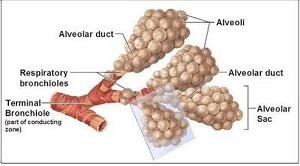Breathing and Exchange of Gases - Online Test
Q1. If TLC is 5500ml, IRV is 2950ml, ERV is 900ml and TV is 500ml then what will be value of RV ?
Answer : Option B
Explaination / Solution:
RV = TLC - IRV – ERV– TV.
substitute the values
RV = 5500-2950-900-500= 1150ml.
Q2. The correct sequence of respiration is i) Breathing in oxygen ii) Transportation of gases by the blood iii) Diffusion of gases between blood and tissues iv) Diffusion of gases across alveolar membrane v) Using of oxygen and releasing of carbondioxide
Answer : Option B
Explaination / Solution:
Respiration involves breathing or pulmonary ventilation by which atmospheric air is drawn in, Diffusion of gases across alveolar membrane, Transport of gases by the blood, Diffusion of gases between blood and tissues.Utilisation of oxygen by the cells.
Q3.
Match the following:
| Animal | Respiratory Organ |
| a) Nereis | i) Book Lungs |
| b) Limulus | ii) Book Gills |
| c) Palaemon | iii) General Body Surface |
| d) Palamnaeus | iv) Parapodia |
| e) Dugesia | v) Gills |
Answer : Option D
Explaination / Solution:
Respiratory organ of Nereis is parapodia, Limulus is book gills, Palamnaeus is book lungs and respiratory organ of Dugesia is general body surface. Palaemon respire through gills.
Q4. Those bronchioles which divide into alveolar ducts are called as :
Answer : Option C
Explaination / Solution:
Terminal bronchioles give rise to respiratory bronchioles that ultimately lead to the alveoli. Exchange of gases takes place in alveoli with blood veseels.
Q5. Which part of our respiratory system doesn’t need ciliated epithelium and thus have non-ciliated walls ?
Answer : Option D
Explaination / Solution:
Respiratory system does not need ciliated epithelium and thus have non-ciliated walls such as alveoli. Alveoli are the balloon like structure at which exchange of gases takes place.
Q6. After a forceful expiration :
Answer : Option B
Explaination / Solution:
After a forceful expiration gaseous exchange continues uninterrupted because there is always a residual volume of air that continues the diffusion of gasese.
Q7. What is the difference between the two given diagrams :


Answer : Option D
Explaination / Solution:
Figure 1 represents the alveoli of healthy person and figure 2 is the alveoli of emphysema patient. The wall of alveoli is get damaged in figure 2 to reduce the surface area for exchange of gases.
Q8. First step in the process of inspiration is :
Answer : Option A
Explaination / Solution:
Inspiration is the process of intake of oxygen from the surrounding. This is achieved by increasing the volume of thoracic cavity. Contraction of diaphragm relax the sternum that increae the thoracic cavity.
Q9. The gaseous exchange portion of the human respiratory tract include/s :
Answer : Option D
Explaination / Solution:
Alveolar ducts are tiny ducts that connect the respiratory bronchioles to alveolar sacs, each of which contains a collection of alveoli (small mucus-lined pouches made of flattened epithelial cells). They are tiny end ducts of the branching airways that fill the lungs.

Q10. Air breathing animals lose a large amount of precious water from their respiratory surface through :
Answer : Option C
Explaination / Solution:
Water is released in atmosphere along with expired air during respiratory cycle. Air breathing animals lose a large amount of precious water from their respiratory surface through evaporation.
